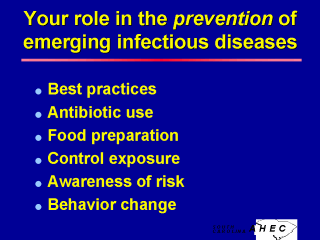| front |1 |2 |3 |4 |5 |6 |7 |8 |9 |10 |11 |12 |13 |14 |15 |16 |17 |18 |19 |20 |21 |22 |23 |24 |25 |26 |27 |28 |29 |30 |31 |32 |33 |34 |35 |review |
 |
The Centers for Disease Control and Prevention is a primary source for scientific information on emerging infectious diseases. Since human behavior is a major factor in the spread of infectious disease, the CDC emphasizes programs that change behavior by influencing individuals and organizations. The CDC also provides guidelines on how to prevent specific diseases or disease problems. These prevention guidelines are implemented in partnership with all health care workers and community groups. As a health care professional, you become part of the network for dissemination of information about prevention of infectious diseases. - Use best practices to prevent infectious disease transmission in personal and professional roles. The first and foremost best practice is HANDWASHING. Others include basic hygiene and the use of personal protective equipment. - Prescribe antibiotics prudently and appropriately, and provide patients with appropriate instruction regarding the importance of completing the entire course of antibiotic therapy. SC has undertaken a statewide physician & patient/parent outreach education program to address this issue. - Follow recommended food preparation and storage guidelines to prevent foodborne disease. - Follow recommended guidelines for vector borne diseases: dress to prevent access, check for ticks, and use insect repellants with DEET if at risk of exposure to mosquitoes. - Be aware of the risk of infectious diseases in professional and personal life. - Change behavior to incorporate preventive measures into daily activities. |
| front |1 |2 |3 |4 |5 |6 |7 |8 |9 |10 |11 |12 |13 |14 |15 |16 |17 |18 |19 |20 |21 |22 |23 |24 |25 |26 |27 |28 |29 |30 |31 |32 |33 |34 |35 |review |